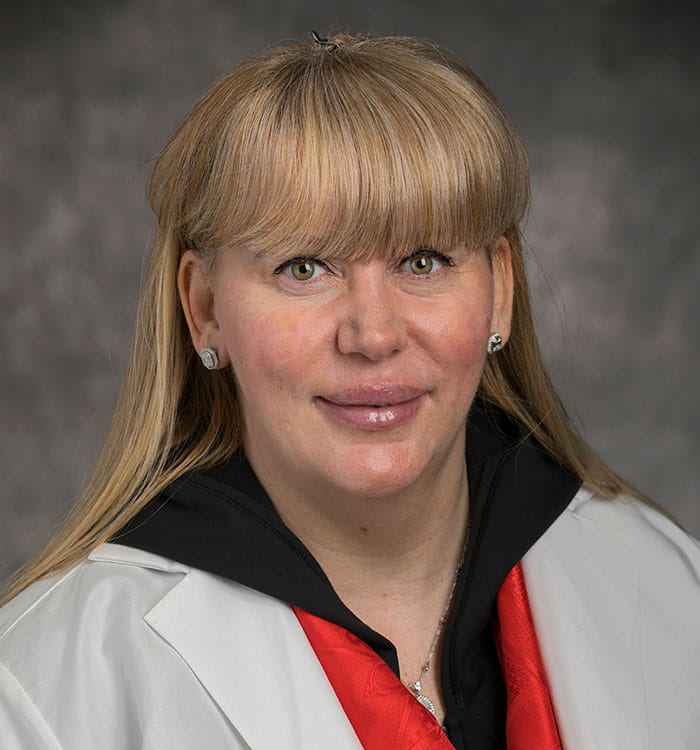Advancing Research at the UH Urology Institute
November 02, 2020
Department looks to tap into artificial intelligence to improve patient care
Innovations in Urology | Fall 2020
 Britt Conroy, MD, PhD, JD
Britt Conroy, MD, PhD, JDUniversity Hospitals Urology Institute is about more than providing outstanding patient care, it’s about changing the very face of urology, says Britt Conroy, MD, PhD, JD, Director of Clinical Research, UH Urology Institute, and Assistant Professor of Urology and Family Medicine & Community Health at Case Western Reserve University School of Medicine.
“The entire department cares deeply about delivering the best patient care and being on the cutting edge of urologic research,” Dr. Conroy says. “We have talent, ideas and so much expertise. It’s really about harnessing these assets and being transformative in the 21st century. We want to shape what urology is going to look like. It’s going to be very different over the next 10 years.”
HARNESSING RESOURCES AND BUILDING A MODEL PROGRAM
The UH Urology Institute leadership team wants to make it easy for dedicated clinician scientists to also contribute to the field of urology, so it has created an infrastructure that supports research.
“Research is interdisciplinary,” Dr. Conroy explains. “There are a lot of pieces, such as compliance with Institutional Review Board requirements, that have to come together, especially in clinical research with patients.”
The key is a well-organized team with excellent compliance, communication skills and a dedication to customer service to shepherd innovative research ideas into well-designed studies and, in some cases, improved patient care. It’s also about being strategic about funding, leveraging internal and external partnerships, collaborating to secure large-scale research grants and using small grants to generate pilot data that then help secure significant research funds.
“We want to build a model program within our institution and inspire, empower and be a resource for other faculty throughout the hospital,” Dr. Conroy says. “Even with fairly new teams, we will have high impact and produce significant results.”
ARTIFICIAL INTELLIGENCE IMPROVES PATIENT CARE
“Artificial Intelligence and data analytics can play a role in the future of urology patient care and healthcare systems in general,” Dr. Conroy says. “In fact, it’s going to change the face of medicine. The healthcare system needs innovations that will improve the quality of care and reduce costs, while simultaneously improving the patient experience.”
At the UH Urology Institute, new faculty member David Sheyn, MD, is already leveraging AI to create complex prediction models to identify patients who respond to specific therapies. Take overactive bladder, for example. Women with overactive bladder often endure multiple failed therapies, sometimes for years, before ultimately finding a therapy that works.
“Wouldn’t it be great to find a quicker resolution for these patients by predicting who might benefit from a particular medicine and who might fail and have to go on to next line therapy?” Dr. Conroy says.
Dr. Conroy and Dr. Sheyn were members of a team of physicians and computer engineers at Case Western Reserve University that developed an accurate AI-based model to predict whether women will respond to anti-cholinergic therapy. This model is currently undergoing testing in a prospective, blinded trial. The team is also developing models for predicting response to treatments of benign prostatic hyperplasia (BPH) and post-operative infections, as well as investigating other areas in urology to apply AI algorithms.
“By using predictive modeling, we can also identify patients at highest risk for progression of prostate cancer,” Dr. Conroy says. “We’re finding that AI is more predictive than other statistical models out there and is changing the face of treatment for prostate cancer, BPH, female incontinence and other urologic conditions.”
PERSONALIZED MEDICINE BENEFITS PATIENTS
The UH Urology Institute is also focused on developing precision tools for cancer care. Jonathan Shoag, MD, another recent addition to the faculty, runs a translational research lab focused on bringing large data, genomic sequencing and novel AI and statistical techniques to patients’ bedside. This includes recent work coauthored by Dr. Shoag, published in Nature Communications, illustrating how BPH, a very common disease of aging, actually has several different subtypes, which may be amenable to precision therapy.
An important part of personalized medicine is understanding an individual patient’s risk. For example, prostate cancer is the second leading cause of cancer death in men in the U.S. In a recent New England Journal of Medicine article, Dr. Shoag illustrates that, over a man’s lifetime, using PSA to understand risk can have substantial benefits, which are likely greater than the harms of screening.
Personalized approaches to urology, and healthcare in general, requires that clinicians also recognize that the community where a person lives influences their overall health trajectory and outcomes.
“Research goes beyond science,” Dr. Conroy says. “It has to be about the community’s needs and conducted in partnership with the community, especially around issues related to health equity and health disparities. The UI is committed to coming up with solutions together.”
The UH Urology Institute welcomes the opportunity to collaborate with faculty from other departments to advance research and improve health outcomes for patients.
For more information about research at the UH Urology Institute you can contact Dr. Conroy at 216-844-3009 or Britt.Conroy@UHHospitals.org.


